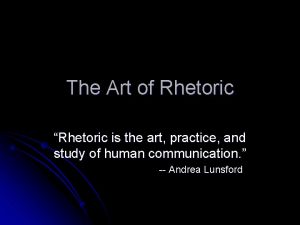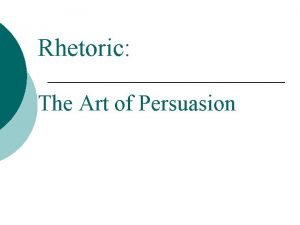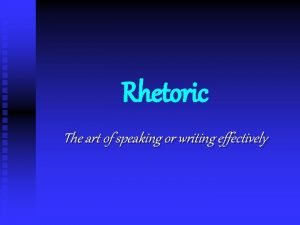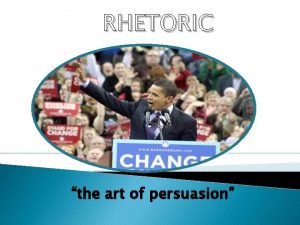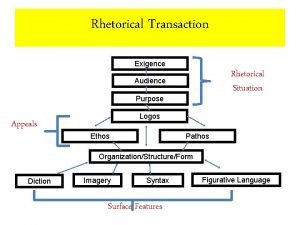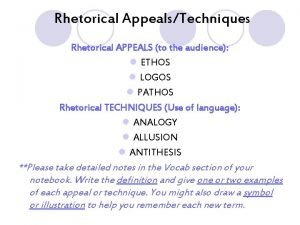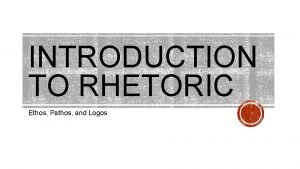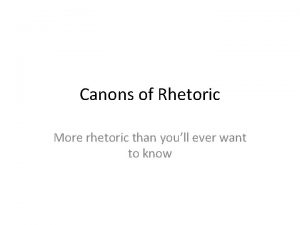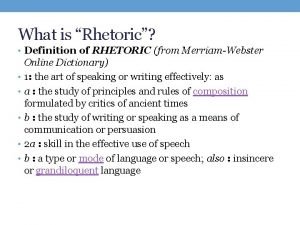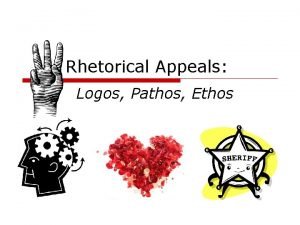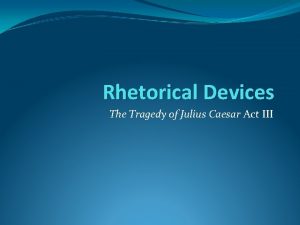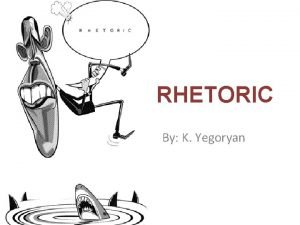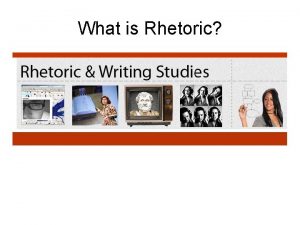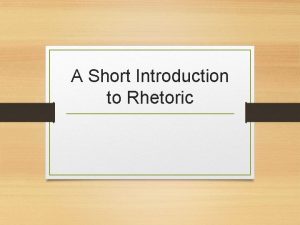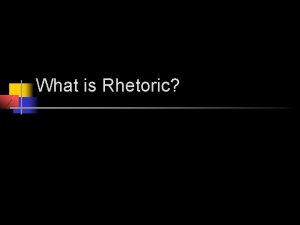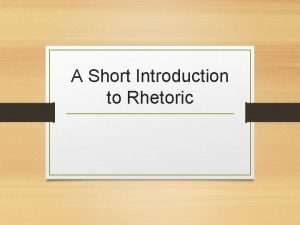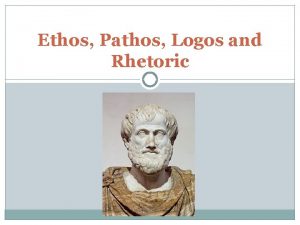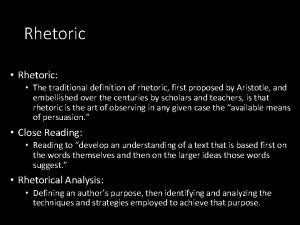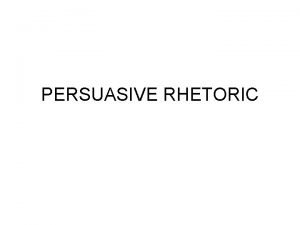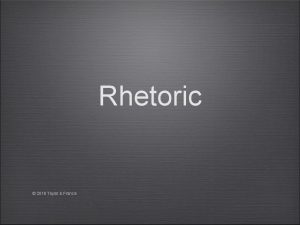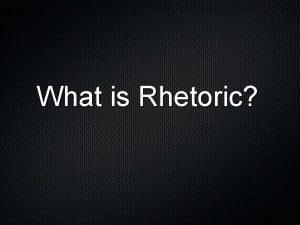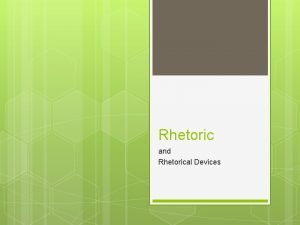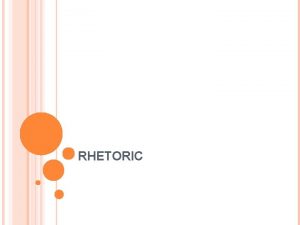THE ART OF RHETORIC Rhetoric The Art of

























- Slides: 25


THE ART OF RHETORIC

Rhetoric = The Art of Persuasion The history of rhetoric and the concepts of persuasion began in Greece.

Meet Aristotle was a famous Greek philosopher who studied the art of persuasion. Plato, another famous Greek philosopher, was his teacher.

Translated from Greek, the word “philosopher” means one who loves wisdom. phil love soph wisdom er one who philosopher

The Art of Rhetoric In approximately 300 B. C. E. , Aristotle, wrote a book entitled, The Art of Rhetoric. In his book, Aristotle identified the three methods of persuasion: PATHOS, LOGOS, ETHOS Plato Aristotle

Pathos, Logos, Ethos PATHOS = pity u appeal to emotion/sex appeal/senses u “awwh” factor u appeal to memory or common experience u poetic persuasion (figurative language) LOGOS = logic u facts u reason u rationales (if…then…) ETHOS = ethics u credibility/trustworthy u authority/superiority in society or subject u doctors, judges, celebrities

Pathos • Pathos = pity (emotion) • Pathos: related to the words pathetic, sympathy, and empathy • Accept a claim based on how it makes you feel without fully analyzing the rationale behind the claim • May persuade you with fear, love, patriotism, guilt, hate or joy

Pathos, cont’d. • Pathos is the use of emotional appeal.

Logos • Logos = logic • An “if…then…” argument • Logos refers to any attempt to appeal to the intellect. • The audience relies on reasoning and facts to make its decision. • Numbers, polls and statistics are also examples of the Argumentative use of logic.

Ethos • Ethos = Ethics • Refers to the trustworthiness of the speaker/writer. • The speaker must establish moral credibility and expertise in his or her field in the minds of the audience When a judge comments on legal precedent, audiences tend to listen because it is the job of a judge to know the nature of past legal cases.

Persuasion in Advertising u. Review each of the following advertisements. u. Each one uses persuasion to sell a product or idea. u. Review each ad and determine which type of persuasion is being used.

#1 Pathos, logos, or ethos? Ethos, Patho s, or Logos ?

Ethos, Pathos, or Logos? #2 Pathos, logos, or ethos?

#3 Pathos, logos, or ethos?

#4 Pathos, logos, or ethos? Ethos, Pathos, or Logos?

#5 Pathos, logos, or ethos?

#6 Pathos, logos, or ethos?

Ethos, Pathos, or Logos? #7 Pathos, logos, or ethos?

Pathos, or #8 Logos? Pathos, logos, or ethos?

Ethos, Pathos, or Logos? #9 Pathos, logos, or ethos?

#10 Pathos, logos, or ethos? Ethos, Pathos, or Logos?

Ethos, Pathos, #11 Pathos, Logos? logos, or ethos?

#12 Pathos, logos, or ethos? Ethos, Pathos, or Logos?

Using Pathos, Logos and Ethos in a Argumentative Essay • In a good argumentative essay, all three types of persuasion should be employed. • Begin with ethos (ethics) to provide reasons and connect with your audience. • Next, employ logos (logic) and make your point with evidence and logic. • Finally, end with pathos (appeal to emotions) to get your reader on your side.
 Rhetoric is the art of
Rhetoric is the art of Rhetoric the art of persuasion
Rhetoric the art of persuasion Ethos pathos logos
Ethos pathos logos The art of speaking or writing effectively is
The art of speaking or writing effectively is Rhetoric: the art of persuasive writing and public speaking
Rhetoric: the art of persuasive writing and public speaking Exigence literary definition
Exigence literary definition Dichotomy vs juxtaposition
Dichotomy vs juxtaposition Branches of rhetoric
Branches of rhetoric You eat what you touch
You eat what you touch Ethos advertisement examples
Ethos advertisement examples Pick it up rhetoric
Pick it up rhetoric Enthymemes in advertising
Enthymemes in advertising American rhetoric 100 speeches
American rhetoric 100 speeches 3 types of rhetoric
3 types of rhetoric Purdue owl visual rhetoric
Purdue owl visual rhetoric Apush period 9 key concepts
Apush period 9 key concepts Antistrophe rhetorical device
Antistrophe rhetorical device Ethos rhetoric
Ethos rhetoric Enumeration rhetorical device
Enumeration rhetorical device Space cat choices examples
Space cat choices examples Rhetoric literary devices
Rhetoric literary devices Anecdote ethos pathos logos
Anecdote ethos pathos logos Canons of rhetoric
Canons of rhetoric Rhetoric definition
Rhetoric definition Ethos, pathos, logos
Ethos, pathos, logos Rhetorical devices in julius caesar
Rhetorical devices in julius caesar
